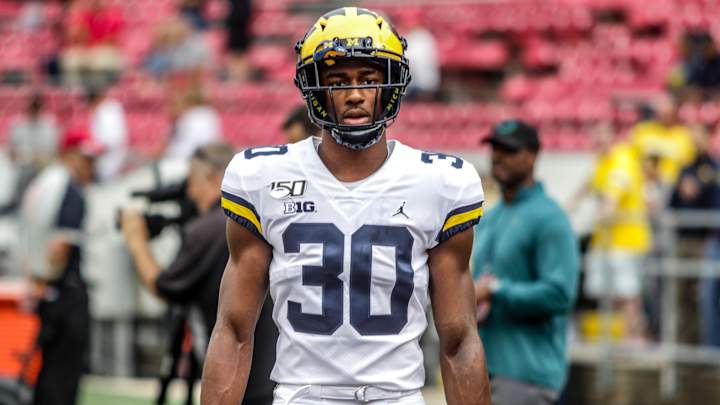Michigan Secondary In 2020: The Best Of The Harbaugh Era?

After finishing top three nationally in passing yards allowed per game in each of its first four seasons under Jim Harbaugh—including twice claiming the top spot—and averaging under 160 yards yielded per contest all four years, Michigan’s pass defense took a step back in 2019.
The 185.5 yards given up through the air per game was still good for 10th-best in the country, but a closer look at the stats provides a glimpse of a defensive back unit that did not meet the lofty expectations set by previous iterations under defensive coordinator Don Brown.
The Wolverines finished outside of the top five in the conference in surrendering 6.9 yards per attempt (8th Big Ten) and 16 passing touchdowns (6th Big Ten), and its 126.1 defensive passing efficiency rating was only the seventh-best in the league.
Late-season struggles against the potent passing attacks of Ohio State and Alabama, in addition to getting torched by Buckeye crossing routes in 2018, raise legitimate and deserved concerns about the ability of the group, and scheme, to produce against championship-level competition in a sport increasingly dominated by high-octane air attacks with each passing year.
In losses to OSU and the Crimson Tide, U-M’s defensive backs were torched for 11 passes of at least 20 yards, including six longer than 40 yards, and four touchdown passes of 30-yards or more. The two explosive foes combined to connect on 59.6 percent of pass attempts for 640 yards and seven touchdowns.
The good news is Michigan will employ a talented starting four, perhaps the best returning group in the conference and, arguably, the best safety tandem of the Jim Harbaugh era. There is talent behind them, too, but it is unproven, with all expected depth contributors redshirt sophomores or younger.
Cornerback Ambry Thomas’s decision to return for his senior season was massive. One of the fastest players on the roster, Thomas made significant strides in the technique necessary to thrive in Michigan’s man-coverage defense en route to earning third-team all-conference honors. If he continues to harness his speed and improve upon the intricacies of the position, he is poised to provide the Wolverines with another true shutdown corner with first team All-Big Ten potential.
Despite being sidelined by colitis and losing more than 35 pounds during fall camp, Thomas started every game during the 2019 season and recorded 38 tackles, including 3.5 tackles for loss, three interceptions, seven pass breakups and two fumble recoveries.
Redshirt sophomore Vincent Gray currently projects to start opposite Thomas, although he will be pushed by redshirt sophomore Gemon Green and a pair of redshirt freshmen in DJ Turner and Jalen Perry. Also keep an eye on four-star 2020 signee Andre Seldon. An early enrollee, he has supposedly already added 10 pounds to his 5-8, 154-pound frame.
A former three-star recruit, Gray made a surprisingly smooth transition into the third cornerback role a year ago, maturing on the field into an effective supporting piece while displaying the tools necessary to grow into an effective starter at the position. Seeing action in all 13 games, Gray tallied 13 tackles, including 1.5 behind the line of scrimmage, and five pass defenses.
Safety represents one of the Maize and Blue's strongest position groups, with sophomore Daxton Hill positioned for a breakout season and senior Brad Hawkins aiming to build off a season in which he was named the team’s Most Improved Defensive Player and an All-Big Ten first-team selection by Pro Football Focus.
While losing graduated senior Josh Metellus will leave a gap in leadership on the field, both Hill and Hawkins should be better suited to stifle dynamic pass attacks.
Hill, a former five-star prospect, is touted as the fastest player on the team with a 4.3 40-yard dash and possesses every physical tool to become an All-American-caliber player. A rare talent that can cover slot receivers, provide run support and track the deep ball with ball-hawking capabilities, Hill took over a starting safety spot in November due to an injury suffered by Hawkins, and notched 19 tackles and an interception over the last three games of the season.
In total, he made 36 stops, including three tackles for loss, intercepted a pass and recovered two fumbles. If he can learn from his rookie growing pains and make a significant leap in his first full season with the first team, he represents an explosive centerfield safety that can mitigate many of the big plays that plagued U-M down the stretch in 2019.
Hawkins has good size for a safety, at 6-1, 218 pounds, and has fit nicely into the role since relocating from wide receiver after his freshman season, but he needs to add more consistency to his game in his final collegiate season. He stockpiled 42 tackles in the first six games last year, including two 10-tackle efforts, but took down only 11 ballcarriers over the next four. In total, he made 53 stops before the injury kept him out of action for the majority of U-M’s final three games.
If healthy, Hill and Hawkins will dominate a majority of the first-team reps, but an injury to either could derail the unit in a significant way. A slew of underclassmen are one play away from being thrust into action—notably redshirt sophomore Sammy Faustin and redshirt freshman Quinten Johnson. It would not be surprising for newcomers Jordan Morant, RJ Moten and Makari Paige to produce early due to lack of experienced depth.
Prediction: Michigan intercepted only nine passes in 2019, ranking them 10th in the Big Ten. Both Thomas and Hill have the potential to be game-changing playmakers, and this number will jump significantly in 2020.
Just as Gray stepped up and blossomed into Big Ten-caliber player as a redshirt freshman, one of Gemon Green, DJ Turner or Seldon will step up and make an impact as a third cornerback and stake their claim to one of the starting spots for 2021.
While it is nearly impossible to contain the high-flying pass-happy offenses of today's college football, and the numbers overall may appear to be a unit taking a step back, this will be the best secondary of the Harbaugh era, largely because it will feature the two best safeties U-M has ever had starting next to each other.
Hill is an elite athlete and Hawkins is an above-average athlete. Throw in Thomas, who has All-American potential, and this will be a unit that finally has the high level skills to match up with Ohio State. Will it be enough? Much of that will depend on the pass rush generate and what Michigan's offense does in Columbus.
